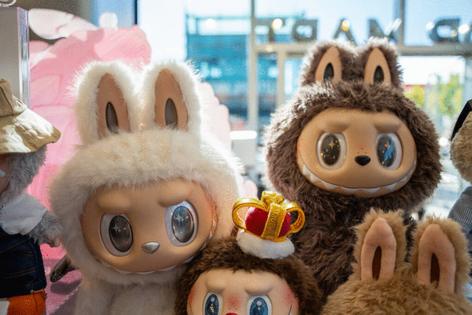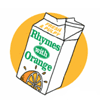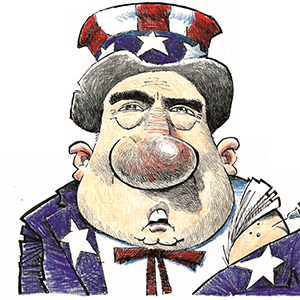Commentary: Can Labubu overcome Hollywood's toy-to-film curse?
Published in Entertainment News
What are Labubus? It’s a question the luckiest among you have likely never had to ask or answer; I, as a parent of two preteens, have had to do both. They’re the latest inexplicably fashionable trend in overpriced toys — tiny creatures that look something like a cross between Keebler elves and Tasmanian devils. And now, apparently, they’re going to be movie stars.
The Hollywood Reporter revealed last week that Sony Pictures has inked a deal securing the screen rights to the Pop Mart International Group Ltd. doll brand. Details about the creative personnel involved haven’t been announced, nor even whether the feature film will be animated or live-action. In other words, it appears that the deal came first, and Sony will figure out those nagging little details down the line.
A lack of clarity comes with the territory for projects in early development. But this particular film — based on a toy introduced in 2015 that became a global force only in the past year — makes the unknowns a little more striking. There are few Hollywood endeavors as futile as chasing flash-in-the-pan trends. And few flash-in-the-pan trends have proven as commercially disappointing for filmmakers as toy brands.
"Bratz: The Movie" is a particularly apt example, as it too was based on a line of popular small dolls. The brand debuted in 2001, and the film followed six years later, grossing $26 million worldwide — barely covering its estimated $20 million budget. But going back to the ‘80s helps paint a clearer picture. In 1987, live-action "Masters of the Universe" — based on toys that hit shelves in 1982 — pulled in $17.3 million, not even enough to cover its $22 million budget. A year later, "Pound Puppies and the Legend of Big Paw," based on the Pound Puppy line created in 1984, cost an estimated $6 million to make but barely hit half a million dollars in ticket sales.
The list goes on. Even toy brands that have become nostalgic favorites initially failed to convert their popularity with kids into ticket sales. Transformers, for example, has become a lucrative and long-running movie franchise, but it took years of ubiquity (and, possibly, the aging of its initial target audience from kids to parents) to set the stage for that success. The toys hit shelves in 1984, and the initial cinematic outing, 1986’s "The Transformers: The Movie," stalled out badly enough ($5.8 million against a $6 million budget) to short-circuit the brand’s multiplex ambitions for decades.
These quickie cash-grabs frequently failed because audiences recognized what they were: feature-length commercials, often extensions of the after-school cartoon shows based on the same toys, which kids could watch ... for free.
Despite repeated flops, today’s studio executives remain subservient to intellectual property, ignoring what should be obvious financial and creative risks — even as recent examples prove that IP doesn’t always guarantee profitability. This faith in brand familiarity may explain why Sony appears to be overlooking the toy-to-film pipeline’s well-documented failures and — as other outlets have noted — seemingly focusing instead on the most obvious counterexamples: 2014’s "The Lego Movie" and 2023’s "Barbie."
The desire to chase their success is understandable. "The Lego Movie" grossed $470 million worldwide on a $60 million budget and was nominated for an Oscar and a Golden Globe, while "Barbie" brought in $1.4 billion worldwide on an estimated $100 million budget and was nominated for eight Oscars (winning one) and nine Golden Globes (winning two).
But those two hits are barely applicable for one key reason: timing. It’s a factor that comes into play in two ways. First, there is proven brand longevity. The Lego Group was established in 1932, while Ruth Handler, co-founder of the Mattel Inc. toy company, introduced the Barbie doll in 1959. So by the time their high-profile movie adaptations were released, Lego and Barbie were both beloved toy brands that had been entertaining children (and emptying the wallets of their parents) across multiple decades and generations. The films didn’t just appeal to kids either — mature plots and a wave of nostalgia made them attractive to grown-ups reminiscing about their childhoods, many of whom still collect or even play with the toys.
Meanwhile, analysts are already questioning whether the mania surrounding Labubus can last, which brings us to the second piece of the timing puzzle. Motion pictures, as a general rule, are not ideal for rapid responses to cultural trends because the production period for a major movie is inevitably and inherently slow. It typically takes a minimum of a calendar year to get a movie from a green light through development, scripting, casting, production and editing — and often, it takes longer. For a toy that hasn’t yet proven its staying power, a year can feel like an eternity in a market where so many companies fight for the public’s ever-shrinking attention span.
Every film must weather its own specific circumstances, of course. Can the Labubu craze last long enough to overcome the historical precedents? Will the celebrities and luxury brands that have boosted and/or partnered with the brand keep those little monsters in the public eye long enough to make "The Labubu Movie" (or whatever title they settle on) into a Barbie-sized hit?
The answers, at best, are maybe. And that kind of uncertainty around the financial prospects of a film like this, seemingly driven by commerce over art, means that Sony might soon experience buyer’s remorse.
———
This column reflects the personal views of the author and does not necessarily reflect the opinion of the editorial board or Bloomberg LP and its owners.
Jason Bailey is a film critic and historian. He is the author, most recently, of "Gandolfini: Jim, Tony, and the Life of a Legend."
©2025 Bloomberg L.P. Visit bloomberg.com/opinion. Distributed by Tribune Content Agency, LLC.













Comments